人教版Book4Unit4reading
人教版高一英语 必修 4 Unit 4 reading 知识点总结(51张)
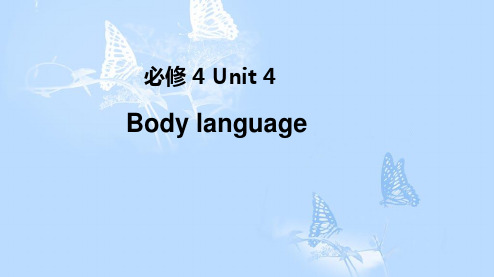
(2)representation n.
表现;描述,描绘
(3)representative n.
代表
adj. 典型的,有代表性的
[温馨提示] 同义词表示“代表”:on behalf of, stand for。
【活学活用】 (1)The museum had several paintings representing the artist's early style. 博物馆藏有几幅代表这个艺术家早期风格的油画。 (2)The chairman represented the importance of the bill to the audience. 主席向听众说后置定语 ___T__h_e__fi_r_s_t_p_e_r_s_o_n__t_o_a_r_r_i_v_e___ (第一个到达的人) was Tony Garcia from Colombia, closely followed by Julia Smith from Britain. 2.not all…表示部分否定,意为“并非所有的” ___N__o_t_a_l_l_c_u_l_t_u_r_e_s_g_r_e_e_t__e_a_c_h__o_th__e_r_t_h_e__sa__m_e__w__a_y____ (各种文化背景下的人互致问候的方 式不尽相同), nor are they comfortable in the same way with touching or distance between people.
(3)语法填空。 ①The subject is so difficult;I really don't know how to represent it___t_o___ you. ②The study was carried out in one small town, so we couldn‘t be sure that the results were truly _r_e_p_r_e_s_e_n_t_a_t_iv_e___(represent). ③The competition attracted over 500 players___r_e_p_r_e_s_e_n_t_i_n_g____ (represent) eight different countries.
book4_unit4_reading人教版高中英语必修四第四单元
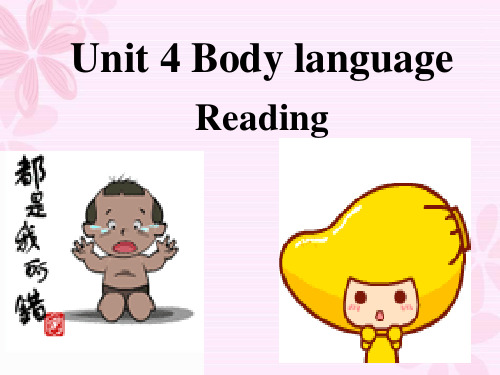
languages are bad. F
5.All members of a culture behave in the
same way.
F
TASK 3:Answer the following questions
1. Is the author of this passage male or female? How do you know ? 2.What were the two mistakes that the author noticed? 3.How can we understand “These actions are not good or bad”?
Fill in the blanks
Body language is used by people for sending messages to one another. In many countries in
the world, men k_is_s__ each other when they meet. In Britain, people usually s_h_a_k_e_ hands
think deeply
stomachache go this way
【课堂互动探究】
Look at the pictures. What are the following ways of communicating?
gesture
posture
facial expression eye contact
Para.1
ParSt.u2mmaDriizfefetrheentmsatuindeidnetas haaccvoerddiifnfegrteont (Parat.h2e-3m) eagnreinetginagndcuksetyomweorrsd. s.
人教版小学英语新起点 四年级下册Unit4 第四单元知识点精析
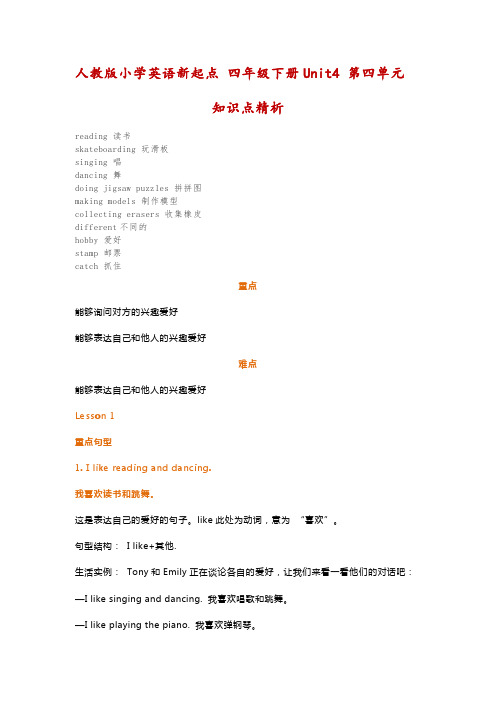
人教版小学英语新起点四年级下册Unit4 第四单元知识点精析reading 读书skateboarding 玩滑板singing 唱dancing 舞doing jigsaw puzzles 拼拼图making models 制作模型collecting erasers 收集橡皮different不同的hobby 爱好stamp 邮票catch 抓住重点能够询问对方的兴趣爱好能够表达自己和他人的兴趣爱好难点能够表达自己和他人的兴趣爱好Lesson 1重点句型1. I like reading and dancing.我喜欢读书和跳舞。
这是表达自己的爱好的句子。
like此处为动词,意为“喜欢”。
句型结构:I like+其他.生活实例:Tony和Emily正在谈论各自的爱好,让我们来看一看他们的对话吧:—I like singing and dancing. 我喜欢唱歌和跳舞。
—I like playing the piano. 我喜欢弹钢琴。
2. like的用法(1)like作动词,意为“喜欢”,有对某人某事或某物赞许或产生兴趣的含义。
① like sb./ sth.意为“喜欢某人/某物”。
例:I like apples.我喜欢苹果。
②like与动名词连用,即like doing sth.,在意义上相当于enjoy doing sth.,意为“喜欢做某事”,表示经常性的习惯或爱好。
例:I like singing very much.我非常喜欢唱歌I don't like drawing. 我不喜欢画画。
③like与动词不定式连用,即like to do sth.,意为“喜欢做某事”,表示具体的一次行为。
He likes to playfootball at weekends. 他喜欢在周末踢足球。
(2)like 作介词,意为“像”。
例:He looks like hisfather.他看起来像他的爸爸。
Book4Unit4Animal Body Language(2021年高中英语人教版)
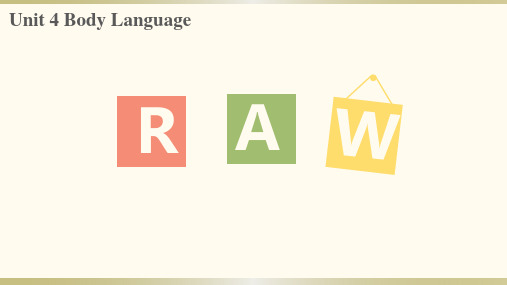
Writing
move its tail tails put its tail between its legs
stand straight out from the body
Language Exploring
Language to show animal body language
ear signals & gestures
1
Main idea: How some of our animal friends
send messages to us and to each other using
body language.
2 34
Scanning
Scan the passage and draw a mind-map to show the following information.
3
Pre-writing What are the commom language used by cats? purr meow stretch swish its tail nuzzle its head agaist
Pre-writing
The cat goes over to the girl and nuzzles its head against her face, giving a meow.
35%
The cat leads the sleepy girl into the kitchen, looking behind her and meowing all the way.
The cat looks up happily at the girl as she pours cat food into the bowl.
Unit4 Reading for writing写作课件 高中英语人教版必修第一册

children when water started filling my home. We had to leave everything and run to safety⑫,” said Chandra Theeravit, a
local Thai woman.
[4]dead in Thailand 为 主语Another 254的补足 语 ; 54 in three other countries为省略句,全 句 为 “54 were found dead in three other countries”。
[3] 此 处 是 过 去 分 词
and cars were swept away② by huge waves③ [3]caused by the
短语作后置定语,
strong earthquake that reached a magnitude of 9.0. The undersea 修饰waves;该结构
Following events
Summary
event date place effect
cause
What is a summary?
What is a summary?
A summary is a short statement of main points.
人教版book4u4知识点(学生版)必修四 Unit 1 Women of achievement

B4U1 Women of achievement Language points核心单词1. achievement n.[C]成就;功绩;\[U\]实现;完成;达到联想拓展achieve v.取得,实现achieve an aim/a goal达到目标achieve success 获得成功He received the Nobel Prize for his scientific achievements. 他因科学上取得的成就而获得诺贝尔奖。
Flying across the Atlantic for the first time was a great achievement. 首次飞越大西洋是一个伟大的功绩。
高手过招完成句子①没有人民的支持,我们将一事无成。
Without the support of the people we can .②我只完成了我所希望完成的工作的一半。
I have achieved only half of I hope to do.③祝贺你获得这样完美的胜利。
Congratulations to you (介词) such a complete victory.2. behave vi.举止,行为,表现;(机器等)工作,运转(常与well/badly等副词连用)vt.守规矩;举止有礼常用结构:behave oneself 使某人自己举止规矩Behave yourself; don’t make a fool of yourself. 注意你的举止, 别闹出笑话来。
How is your new car behaving? 你的新车性能如何?联想拓展behaviour n. (人的)言行举止,行为;(动物)习性,自学成才behaviour towards/to... 对……的态度/行为高手过招(1)单项填空①David is quite well in school. He obeys the teachers and gets As in all his subjects. (2009山东潍坊检测)A. behavedB. concernedC. involvedD. respected(2)完成句子①父母让孩子们在客人面前举止礼貌。
Unit 4 Sharing Reading Thinking 课文高中英语人教版选择性必修第四册
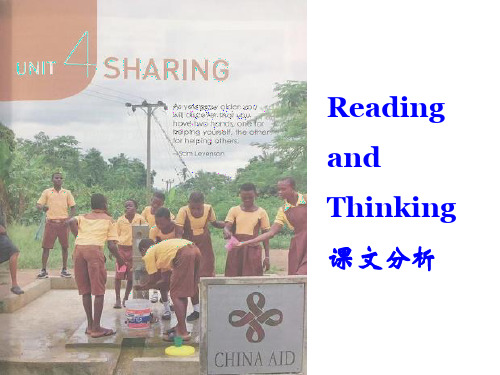
宾语从句。
let alone
需跟与前面相同的平行结 Today, some young
构。用在否定句后,表示 people never even read
由于极可能发生的事情都 没有发生,某种情况就更
a newspaper, let alone
不可能了。
a book.
【语境应用】用let alone或not to mention完成句子。 1) They have three dogs to look after, __n_o_t__to__m_e_n_t_i_o_n_/_
some sweets and jam from home; I’ve
been dying to have some of my
be dying to do sth ቤተ መጻሕፍቲ ባይዱ望做某事
favourite sweets, and it’s always nice to
get mail!
1. I’ve been dying to have some of my favourite sweets, and it’s always nice to get mail!
我一直非常渴望吃一些我最喜欢的糖果,而且 收到邮包总是令人开心不已。
be dying for / to do sth: to be extremely eager to have / do sth 极想得到,渴望得到,渴望做某事
eg I’m dying to hear your news. I’m dying for something to eat.
➢ in chorus all together; in unison
同时;一起
eg There was a chorus of agreement from the committee.
高中英语 Book4 Unit4body language 说课课件 新人教必修4(通用)
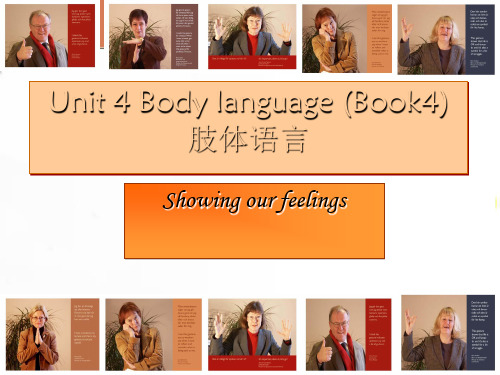
1). Analysis of the teaching material 教材分析
The type of this class is an extensive reading class, which plays an important part in developing students’ reading ability. So,during the teaching process, the teacher should focus on developing the students’s reading ability by extensive reading, and get them to learn some reading skills such as skimming, scanning and so on. Moreover, the students should receive some moral education, let them know more about body language in cultures in different countries.
课前探索(Pre-class Exploration):
Let students search for more information about body language which shows different meanings in different cultures and countries.
掌握该部分的重点词句
3.Let students read and understand the passage “Showing our feelings”.
让学生读懂本篇文章
Teaching difficult points (教学难点)
book4unit4warming up &reading
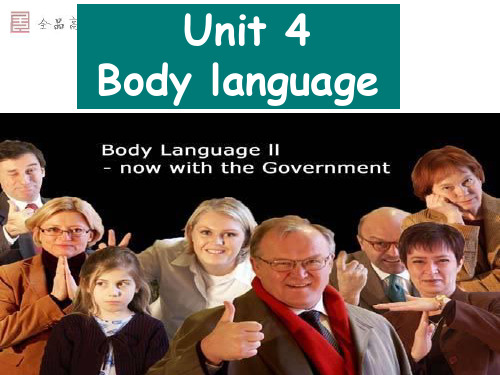
Answer questions
1.Why are the people visiting China? 2.Why is Julia Smith surprised? 3.What do French people often do when they meet people they know? 4.Why do you think we need to study body language?
gestures
OK
stop
silent
well done
Facial expressions
happy
angry
sad
confused
postures
She is feeling ill / having a stomachache.
He is thinking deeply.
eye contact
Ahmed Aziz
China
Columbia Britain Japan Canada Jordan France
Akira Nagata
Tony Garcia
George Cook
Julia Smith
Darlene Coulon
Fast reading
Divide the passage into four parts and match the main idea of each part.
Some body language is different in different countries.
What do people usually do when meeting? In China, Britain In Russia, France, In Arab, Japan, Korea In Some western countries Shake hands Kiss Bow hug
新课标人教版必修四Book4 Unit4 Language points

car?
我只是出于好奇, 请问你买这辆车花了多少钱?
1. ______ about wild plants that they decided to make a trip to Madagascar for further research A. So curious the couple was B. So curious were the couple C. How curious the couple were D. The couple was such curious
likely 常用于如下结构: sb./sth. is likely to do sth; 很可能…;有希望… It’s likely that-clause. 注意:likely 的主语可以是人也可以是物, 但不说: It’s likely to do sth. He’s very likely to be late for class. It isn’t likely to rain.(it表天气,并非形式主语.)
3) At the meeting they discussed three different _____ to the study of maths.
A. approaches
C. methods
B. means
D. ways
4)
the city center, we saw a stone statue of about 10 meters in height. A. Approaching B. Approached
Not both…= both…not “不是两个都” 1)I don’t know all of them. 我并不全认识他们。 2)I don’t like both of the books. 这两本书我并不都喜欢。
Unit 4 Reading and Thinking示范课教学课件【英语选择性必修第二册人教版】

The last part is paragraph 6 showing body language has many different uses.Example 1: A smile can help get through difficult situationsExample 2: A smile can break down barriersExample 3: A smile can serve as an apologyExample 4: A smile can be used to ask for help
Reading
The third part is paragraph 5 showing that some gestures are universal.Example 1: the gesture meaning sleepExample 2: the gesture meaning “I'm full”
罗兰·巴特(Roland Barthes,公元1915年11月12日—公元1980年3月26日),法国作家、思想家、社会学家、社会评论家和文学评论家
So body language is more powerful than spoken language.
Reading
The whole passage consists of 6 paragraphs. 1. How many parts can the 6 paragraphs be divided into?2. Which paragraph belongs to which part?
OK gesture
OK, agreement
Nodding one's head
人教版高中英语必修4 第四单元unit4单词讲解

重点单词.词组讲解1. greet vt. 问候,迎接,招呼(+with)She greeted her guests at the door.She greeted him with a smile. greet sb.with...用……向某人打招呼(欢迎某人) greeting n. 招呼,问候She waved a friendly greeting.【期末测试】Whenever I met her, _________ was fairly often, she greeted me with a sweet smile.A. whoB. whichC. whenD. that【2013新课标2完形】23.A.helps B .chooses C. greets D. sees 【2013广东】The next day Tom appeared as the powerful Superman waving his hand to the people greeting him along the way.2. represent1)vt.象征;表示;The dove represents peace.2) vt.作为...的代表They said that they represented the committee. 他们说他们代表该委员会。
区别:represent,stand forrepresent “表示,代表,说明”多用于实体代表,有被动。
stand for “代表,意味”多用于抽象事物代表。
一般指符号或标志等,无被动。
The dove represents peace.U.N stands for the United Nations.【2015安徽】In many cultures, round foods such as grapes, bread, and moon cakes are eaten at welcome celebrations to represent family unity.3. association1)n.协会,公会,社团[C]Have you joined the teachers' association?2)n.联想,联想物[C][U]He has no association with foreigners. have (no)association with...与…有(没有)联系associate v.联想,把...联想在一起They associate turkey with Thanksgiving. associate...with...把……与……结合起来【2012北京完形】48. A. attention B. association C. attraction D. adaptation 【2014浙江】We associate piggy banks with children4.curious adj. 好奇的,渴望知道的The boy was curious about everything he saw. be curious about 对……感到好奇He’s curious to know what she said. be curious to do sth. 渴望做……curiously adv. 1. 好奇地2. 奇异地,奇怪地;说来古怪He looked curiously at the people.curiosity n. 好奇心She did that just out of curiosity. from/out of curiosity 出于好奇【期末测试】People have always been about exactly how life on earth began.A. curiousB. excitedC. anxiousD. careful【期末测试】Little Johnny felt the bag, curious to know what it ____.A. collectedB. containedC. loadedD. saved【2014新课标1】you can take a photo or write a poem that shows what they are curious about.5. approach vt. vi1) 接近,靠近(可指距离或时间)When I approached, they grew silent.2) 找...商量Did Mary approach you about lending her some money?approach sb. on/about sth.与某人接洽/商量某事名词n.1) 接近,靠近;即将达到[U][(+of)]Snow announced the approach of winter.2) 通道,入口[C][(+to)]All approaches to the village are blocked.3) 方法,方式;态度I like her approach to the problem. approach to 接近;近似;(做某事)的方法(途径) 可以与介词to搭配的名词有:answer/key,entrance,visit(or),way/road,guide,monument等。
Unit 4 Natural Disasters Reading高中英语人教版(2019)必修第一册

The boy __in__ju_r_e_d_ his leg. 2.你的话也许会伤她的自尊。
Your remark may ___in__ju_r_e_ her pride. 3.我并未打算伤害她。
高中英语必修Book 1
Unit 4 Natural Disasters
Reading and Thinking Language points P50-51
The Night the Earth didn’t sleep
✓ To read a text about Tangshan earthquake and gather information
2 Mice ran out of the fields looking for places to hide, and fish jumped out of the water.
句意:老鼠从田野里跑出来寻找藏身之处,鱼也从 水里跳了出来。
out of sth 越出...之外 come out of 从…出来,由…产生 run out of 跑出来 jump out of 跳出来
伴随状语使用的分词有V-ing和V-ed两种形式。 例: The dog entered the room, following his master 这条狗跟着主人进了屋。 The master entered the room, followed by his dog. 主人进了屋,后面跟着他的狗。
例: 我们看见他从房间出来。
We saw him _c_o_m_e__o_u_t_o_f the room.
2 Mice ran out of the fields looking for places to hide, and fish jumped out of the water.
新课标人教版必修四Book4 Unit4 Reading
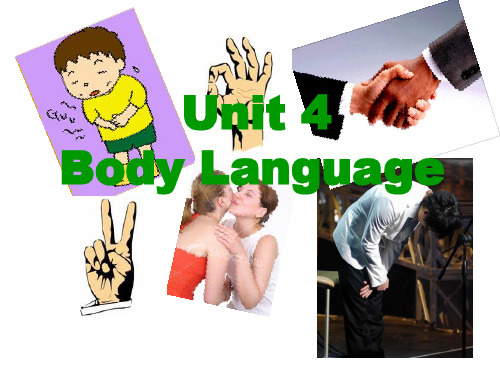
Ways to greet each other Approach others closely and are more likely to touch them. Shake hands, do not stand very close to others or touch strangers when they meet. Bow Shake hands. Shake hands and stand quite close to other men. Nod to women but do not shake hands with them.
我的课堂我做主
Assignment(任务分配)
Group1. → Question (3,4). Group2. → Question (5). Group3. → Question (1). Group4. → Question (2). Group5. → Question (6). Group6. → Question (7).
Japan: bow
Some western countries: hug
Russia, France, Arab: kiss
Reading
Communication:
No problem?
Learning aims
• 1、To learn some new words and phrases. • 2、To know different body languages represent different meanings. • 3、To respect other country’s body languages.
Why do we need to study body language?
【教案】Unit 4 Reading and Thinking 教案人教版(2019)必修第一册
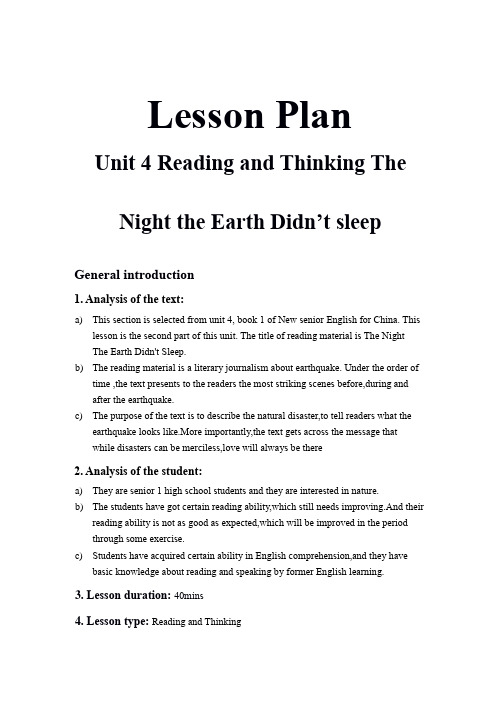
Lesson PlanUnit 4 Reading and Thinking TheNight the Earth Didn’t sleepGeneral introduction1. Analysis of the text:a)This section is selected from unit 4, book 1 of New senior English for China. Thislesson is the second part of this unit. The title of reading material is The NightThe Earth Didn't Sleep.b)The reading material is a literary journalism about earthquake. Under the order oftime ,the text presents to the readers the most striking scenes before,during and after the earthquake.c)The purpose of the text is to describe the natural disaster,to tell readers what theearthquake looks like.More importantly,the text gets across the message thatwhile disasters can be merciless,love will always be there2. Analysis of the student:a)They are senior 1 high school students and they are interested in nature.b)The students have got certain reading ability,which still needs improving.And theirreading ability is not as good as expected,which will be improved in the period through some exercise.c)Students have acquired certain ability in English comprehension,and they havebasic knowledge about reading and speaking by former English learning.3.Lesson duration: 40mins4.Lesson type: Reading and ThinkingTeaching objectives1. Language skills:a)Students can master the strategy of using context to understand new wordwords,summarize the main idea of each paragraph.b)Students can learn some sentences and writing method about describing the naturaldisasters,and they can illustrate the damage that earthquakes have caused to people by listing the figures.c)Students can identify and learn the words and phrases related to natural disastersand can use these words to make sentences:Shake、rise、right away、crack、burst、ruin、injure、survivor、destroy、shock、rescue、disaster......2. Cultural awareness:a)Students can build confidence of reading and speaking after reading and groupworking activities.b)Students can be active and cooperative in team activities and they will learn theimportance of cooperation.c)Students will be aware of the danger of natural disasters and they will also learnsome measures to protect themselves in natural disasters.d)Student will have an awareness of self-protection in disasters.3. Thinking quality:a)Students can broaden their horizons and learn more about history and what ishappening in other regions.b)Learn from the brave people of Tangshan who are rebuilding their homes.4. Learning ability:a)Students can consolidate their former knowledge and practice their reading and writing skills through class.b)Students can take the initiative to think about how to react calmly when faced with natural disasters.c)Students can integrate the known pieces of information into a complete article. Focal points and difficult points1. Focal points:a)Learn some detailed information about an earthquake and aware of the danger ofnatural disaster.b)Train students’ speaking ability by describing the natural disasters,group workingand discussion.2. Difficult points:a)Teach students how to describe natural disasters better and more vividly.b)Teach students to be able to apply the protective measures they have learned todayto their lives.Teaching aidsa)Multimedia, blackboard, ppt.Teaching methodsa)Discussion methodb)Task-based Language teaching methodc)Communicative language teaching methodStep 1 lead-in (3mins)Purpose1.Greeting.2.The teacher will show the students some pictures about natural disasters and ask the students to guess what they are.Wildfire V olcanic eruption Snowslide Mudslide Flood Tsunami 1、Use pictures to introduce the lesson, stimulate students' interest in the natural disasters to be introduced in this lesson, and introduce the topic of this lesson naturally.2、Pictures allows students to have a more visual experience of various natural disasters and leaves a deeper impression on them.Typhoon/Hurricane Drought3.The teacher will show the students a video and find out what kind of disaster is presented.Q:EarthquakeStep 2 Pre-reading (7mins)1.After watching the video,then give the students some pictures about earthquake,ask the students to describe the pictures.(1)Thousands of buildings will fall down/be destroyed.(2)Many people will be trapped or badly hurt.(3)The bridge will be damaged and too dangerous to cross.(4)The railway tracks will be useless pieces of mental.(5)People will be frightened/in shock.(6)The whole city will lie in ruins.2.PredictionAsk students to look at the title and the picture and ask questions.1.Through pictures, students can describe the earthquake, which can exercise their speaking and expression skills and deepen their impressions of the earthquake.2.Prediction can stimulate students’ interest in reading the article and enable students to have a preliminary understanding of the article.(1)What Happen at that night?(2)What is “the Earth didn't sleep” means? Step 3 While - Reading (20mins)Global reading1.Listen to the tape with your textbooks closed and find the topic sentence of each paragraph,then teacher will invite some students to answer: Paragraph 1:Strange things were happening in northeastern Hebei. Paragraph 2:It seemed as if the world were coming to an end. Paragraph 3:Nearly everything in the city was destroyed.Paragraph 4:But hope was not lost.Paragraph 5:Tangshan started to revive itself and get back up on its.2.Ask students find the main idea of each paragraphParagraph 1:Warning signs before the earthquake.Paragraph 2:The happening of the earthquake.Paragraph 3:The effects during the earthquake.Paragraph 4:The rescue work after the earthquake.Paragraph 5:The revival of the city after the earthquake.3.According to the main idea,ask the students divide the passage into several parts.Part 1 (Paragraph 1):Signs before the earthquakePart 2 (Paragraph 2-3):Happening and damage of the earthquakePart 3 (Paragraph 4 -5):The rescue work after the earthquakeDetail readingPart 1 (Paragraph 1):Signs before the earthquakeQ1:What strange things happened before the earthquake?Please underline the strange things.1、By asking students to identify the central sentence of each natural paragraph, it can help students better understand the main idea and the structure of the text.2、Introducing the characteristics of central sentences can help students use this technique in their writing and grasp the main idea of the text better in their reading.3、Reading the details of the distributed parts helps students understand the details of each part of the text.Part 2 (Paragraph 2-3):Happening and damage of the earthquake Q2:Try to find information about damage to city and people and fill in the blanks.(1)1/3 of the nation felt the earthquake.(2)A huge crack that was 30Kilometres long and 8metres wide cut across houses.(3)In less than 1 minute a large city lay in ruins.(4)2/3 of people were dead or injured during the earthquake.(5) The number of people who were killed or badly injured was more than 400000.(6)All of the city's hospitals, 75% of its factories and buildings and of its 90% homes were gone.Q3:Why did the writer use so many numbers?To make the article more convincing,more impressive,and the damage described more shocking.Q4:Figures of speech(1)It seemed as if the world was at an end. -exaggeration (夸夸)(2)Bricks covered the ground like red autumn leaves. -simile (夸夸)(3)No wind, however, could blow them away. -exaggeration (夸夸) Part 3 (Paragraph 4 -5):The rescue work after the earthquake.Q4:Who brought hope to the survivors and what did they do?The army Sent 150000 soldiers to Tangshan to dig outthose who were trapped and to bury the dead Doctors and nurses Came to provide medical careThe workers Built sheltersPeople from all over the country Water and food were brought into the city by train,truck and plane2、Show a few pictures of the new look of Tangshan after earthquake to students,and thinking What does the passage convey? 夸D夸A. No pains, No gains!B. Where there is a will, there is a way.C. All things are difficult before they are easy.D. Where there is life, there is hope.Step 4 Post - Reading (10mins)Group discussionIf you are having the English class, an earthquake occurred. What should you do during the earthquake?· Sit down under your desk.· Don’t be nervous and keep calm.· Don’t try to run out of the classroom in a hurry.· Protect your head by putting your bag on your head.· Leave the classroom quickly after the earthquake.Summary : mind map 1、Help students to put themselves into the role and better experience the feelings that the earthquake brings to people.2、Exercise students' speaking skills.3、Trigger students to think about the earthquake and develop their independent thinking skills.4夸The way of mind map will help students sort out what they have learned in this class more clearly.。
Unit 4 Reading and Thinking高中英语人教版(2019)选择性必修第一册
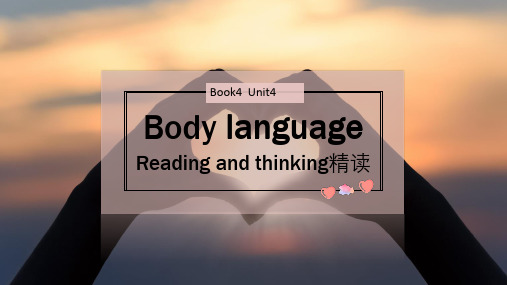
Body language
Reading and thinking精读
Learning Objectives
1.To learn some important language points 2. To anlyse difficult and important sentences propely. 3. To use some important points in senteces.
即学即用 单句语法填空
1. They discussed _v_a_r_i_o_u_s___(vary) matters all over the world.
2. Many graduates seek employment in engineering , aviation,
education, medicine and a wide __v_a_r_ie_t_y_______(vary) of other
vary /ˈveəri/ vi. (根据情况)变化;改变
vary
_v__a_ri_e_t_y____ n. 变化;多样性;不同种类 _v__a_r_i_o_u_s___ adj. 不同的;各种各样的
___________ 各种各样的;不同种类的
a variety of / varieties of
读一读 细观察 1. In the lab, don’t touch anything without your teachers’ permission.
词性__名__词____ 含义__允__许__,__许__可__ 2. You’re not allowed to park here unless you have a permit.
人教版高中英语必修四 Book 4 Unit4 Body Language PPT课件
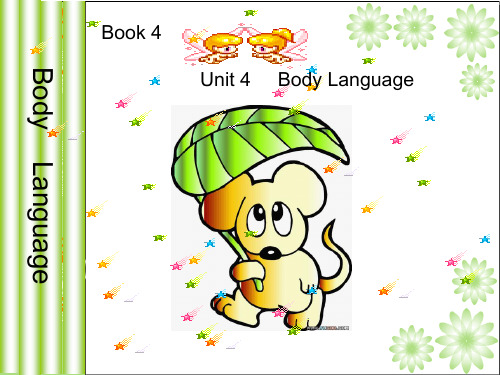
Step 2 pre-reading.
1. What do you think is the purpose of language?Disscuss your opinion with your partner. The purpose of language is to communicate with other people .
2. How can you communicate with someone if you I can use body language to communicate with cannot speak? Give an example. someone if I cannot speak .For example, if I'm angry, I might turn away and not talk to others .If I'm happy to see someone, I might smile and hold out my hand or open my arms. 3. There are many different ways to greet someone Ways to greet someone without words: using words.How many ways can you think of to smile ,wave ,shake hands, hug,kiss,etc. greet someone if you CANNOT speak? Share your ideas with your partner.
Book 4
Body Language
Uபைடு நூலகம்it 4
Body Language
- 1、下载文档前请自行甄别文档内容的完整性,平台不提供额外的编辑、内容补充、找答案等附加服务。
- 2、"仅部分预览"的文档,不可在线预览部分如存在完整性等问题,可反馈申请退款(可完整预览的文档不适用该条件!)。
- 3、如文档侵犯您的权益,请联系客服反馈,我们会尽快为您处理(人工客服工作时间:9:00-18:30)。
Find out the two cultural mistakes in para2
Find out the two cultural mistakes in
para2
He approached Julia,
Tony Garcia _to_u_c_h_e_d__ _h_e_r__
The
(Colombia ) _sh_o_u__ld_e_r__and _k_i_s_s_ed__
what kind of body language do we Chinese people often use to greet each other?
问候
Reading passage:
Communication : No problem?
Fast Reading
What is the main idea of the text? A. Customs in different countries. B. Foreigners from different countries C. Ways to greet in different cultures D. The importance of knowing customs.
when they meet.
Akira Japan
Nagata
George Cook
Canada
bow
shake hands
Ahmed Jordan Stand close to other men
Aziz
But will not touch women
Darlene Coulon
France
shake hands and kiss twice on each cheek
Careful reading
Name country Ways to greet people
Tony Garcia
Colombia
Approach others closely and are more likely to
touch them.
Julia Smith
Britain
Do not stand very_c_l_o_se__to others or _to_u_c_h_straingers
He _b__o_w_e_d__ so his nose_t_o_u_c_h_e_d_George’s _m__o_v_in__g _h_a_n_d__.
• Does the author think body language is bad because of the mistakes?
These actions are not good or bad, they are simplyways in which cultures have developed.
Julia Smith (Britain) Situation2: George Cook (Canada)
Akira Nagata (Japan) Situation3: the writer (China)
Ahmed Aziz (Jordan) Situation4: Darlene Coulon (France)
her on the _c_h_e_e_k___.
First
Why do you think it is a mistake?
mistake
Julia Smith (Britain)
She _s_te_p_p_e_d__b_a_c_k___ appearing _s_u_r_p_r_is_e_d_ and put up her hands, as if _i_n_d_e_f_e_n_c_e_.
George Cook
(Canada)
He _r_e_a_c_h_e_d_ his hand ___o_u_t___ to the Japanese student.
The
second Why do you think it is a mistake?
mi(Japan)
when we are meeting some foreigners, how to avoid the cultural mistakes of body language?
learn
respect
Choose one situation to act it out and let the others guess which situation it is Situation1: Tony Garcia (Columbia)
Tony Garcia (Columbia)
Summary
What have we learnt today?
